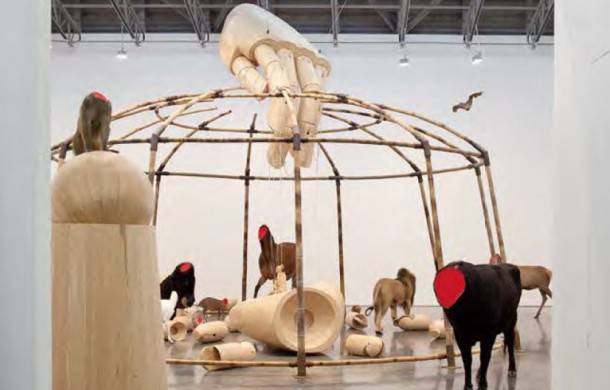HUANG YONG PING: CIRCUS
| May 10, 2013 | Post In LEAP 19

Huang Yong Ping’s “Circus” presents a herd of beheaded taxidermied beasts posed amongst an oversized bamboo cage in Gladstone Gallery’s southernmost Chelsea space. The dome-shaped cage dons a monumental, wooden marionette hand, its strings connected to the skeleton of a robe-clad monkey puppeteering the bones of a smaller monkey— a reference to the trickster monkey king Sun Wukong from the landmark Chinese novel Journey to the West. Both simians perch upon another giant puppet hand, which seemingly fell from heaven to its current tellurian existence scattered on the concrete floor of the exhibition space. Nearby, the taxidermied, headless animals range from predatory lions, bears, and wolves, to horses, goats, jackrabbits, and even a bat suspended mid-flight. The holes gaping from the animal’s necks are draped and pinned with a cottony incarnadine fabric, creating the illusion of a clean, blood-red circle jutting from each chest cavity. Posed as if they were calmly walking through nature— as per custom with most Western taxidermy— the animals appear entranced by the sinister robed monkey king, which is seemingly controlled by the above oversized hand.
Upstairs finds two additional large sculptural works. One, a feat of resourcefulness, recycles the animal heads from Huang’s downstairs installation. The heads are skewered in size descending order onto a thin spear levitating in a small viewing room enclosed by a red sheet. In the adjoining gallery, a taxidermied camel kneels onto what appears to be a prayer rug. The animal’s nose pierced by a knitting needle, a string connects the needle to its branded hide. The text burned into the camel’s trunk references, in French, the Biblical dictum “It is easier for a camel to go through the eye of a needle than for a rich person to enter the Kingdom of God.”
If this exhibition sounds overly complex, it is not— at least not in terms of its conceptual conceit. Its press release states that “Circus” “calls cultural stereotypes and philosophical narratives into question” by “orchestrating a puppet show before fifteen animals,” which in turn questions “who or what is in control, invit[ing] the viewer to reassess his understanding of relationships—both to others and to the world he inhabits.” Thus, the beheaded, dumb beasts represent the common, dumb man blithely floating through life as a sheep in the herd, blissfully unaware of the shadowy forces enacted upon it, lobotomizing it— these forces being religion, politics, or any other man-made metanarrative. No doubt, calling our autonomy into question is a worthy feat— many artists, philosophers, and writers have proved as much since as long ago as, arguably, the dawn of Modernism. Yet, as we age and time marches on, truths and untruths become increasingly entangled and complex. To simplistically represent notions of corruption, power, and control by an oversized, over-budget, levitating marionette hand seems a cheap blow to a tragically overplayed idea.
Huang Yong Ping is a deservedly respected figure of the 1980s Chinese avant-garde, having been a figurehead for the Xiamen Dada group, which provided early implementation of modern Western artistic practices in China, but the artist falters in this contemporary context by proffering lessons that most of us already know. Further problematic is the artist’s usage of obviously debased, barbarized animal carcasses as artistic medium: while I am no PETA member, nor vegetarian, the undeniably harrowing phenomenological affect of interacting with beheaded and formaldehyde-soaked animal remains misconstrues the free-thinking, humanitarian doctrine that this exhibition purports to stand for, and sets any sentient human being on an unintended path away from the intellectual contention of this show. Although Huang has rightfully carved a position in both Western and Chinese contemporary art history, “Circus” evinces the danger of traversing too far into the pandemonium of commercialized cultural production.

